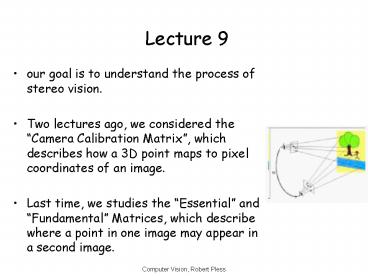our goal is to understand the process of stereo vision. - PowerPoint PPT Presentation
1 / 17
Title:
our goal is to understand the process of stereo vision.
Description:
Two lectures ago, we considered the 'Camera Calibration Matrix', which describes ... (a) Motion field of a pilot looking straight ahead while approaching a fixed ... – PowerPoint PPT presentation
Number of Views:50
Avg rating:3.0/5.0
Title: our goal is to understand the process of stereo vision.
1
Lecture 9
- our goal is to understand the process of stereo
vision. - Two lectures ago, we considered the Camera
Calibration Matrix, which describes how a 3D
point maps to pixel coordinates of an image. - Last time, we studies the Essential and
Fundamental Matrices, which describe where a
point in one image may appear in a second image.
2
Projections one more time!
- The normalized camera helps to simplify
geometric properties. - Today, we consider what happens when points in
the scene move. And a little bit of how to
measure motion on an image.
3
- Simple form allows us to write
- Two reasons points might move
- 1) The point is moving (its a bird, its a
plane) - 2) The world is static, and the camera is moving
- (but if we define the coordinate system to be at
the camera, then all the points move.)
4
- Points moving? How can we possible represent
that?!? - And the instantaneous representation of motion
is? - So how does the instantaneous world motion turn
into instantaneous image motion?
5
- So, how does the apparent speed (the image
speed) of an object relate to - Its speed
- Its distance
- What points look like they arent moving?
6
That was for one point moving.
- Suppose we move the camera, but continue to use
it as the coordinate system. Then all the
points in the world move. How do they move,
(instantaneously?). - Instantaneous motion of the camera can be written
as a translational velocity and an angular
velocity. Commonly, this is written as a pair of
vectors
7
New variables
Z
X
O
Y
8
Calculating a cross product,
Substitute in, if x X/Z, then
X xZ
So, if the camera moves with t, ?, then the world
points move as above. How do the pixels move?
9
Pixel motion defines a vector field.
(a) (b)
(a) Motion field of a pilot looking straight
ahead while approaching a fixed point on a
landing strip. (b) Pilot is looking to the right
in level flight.
10
Examples of Vector Fields II
(a) (b)
(c) (d)
(a) Translation perpendicular to a surface. (b)
Rotation about axis perpendicular to image plane.
(c) Translation parallel to a surface at a
constant distance. (d) Translation parallel to an
obstacle in front of a more distant background.
11
Image Flow due to Rigid Motion
Ambiguities?
12
So, if we can measure u,v (the local motion of
pixels on an image),
- Then we could solve for U,V,W, and the rotation.
- The vector u,v is called optic flow
- Solving for this vector field has long been
considered a key first step in vision algorithms.
A good gyroscopic stabilizer makes the rotation
part zero!
13
Grounding image.
14
Solving with small window, there is The aperture
problem
Normal flow Component of flow perpendicular to
line feature.
15
But, but, but, the world isnt just lines!?!
- Lets go backwards. Suppose you know the optic
flow, u,v, at a pixel (x,y) at frame t. The
intensity of that point is, - I(x,y,t).
- What assumptions can you use to guess how the
intensity will change in the next frame? - We can do a first order taylor series expansion
of the intensity function at that image.
16
- Optic flow is 2d vector on image (u,v)
- Assuming
- intensity only changes due to the motion.
- The derivitives are smooth
- Then we get a constraint Ix u Iy v It
0 - Defines line in velocity space
- Require additional constraint to define optic
flow.
17
Solving the aperture problem
- How to get more equations for a pixel?
- Basic idea impose additional constraints
- most common is to assume that the flow field is
smooth locally - one method pretend the pixels neighbors have
the same (u,v) - If we use a 5x5 window, that gives us 25
equations per pixel!































